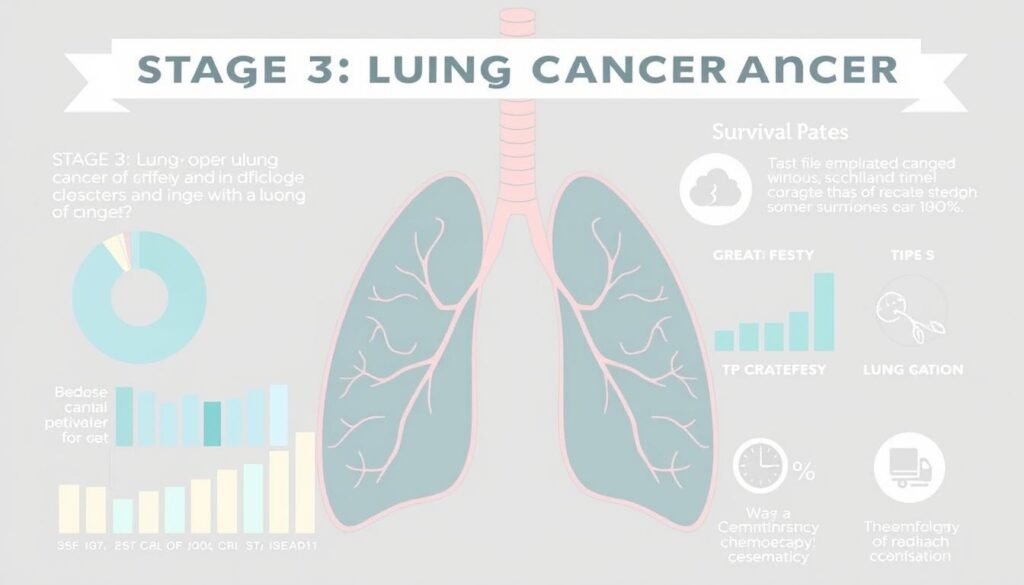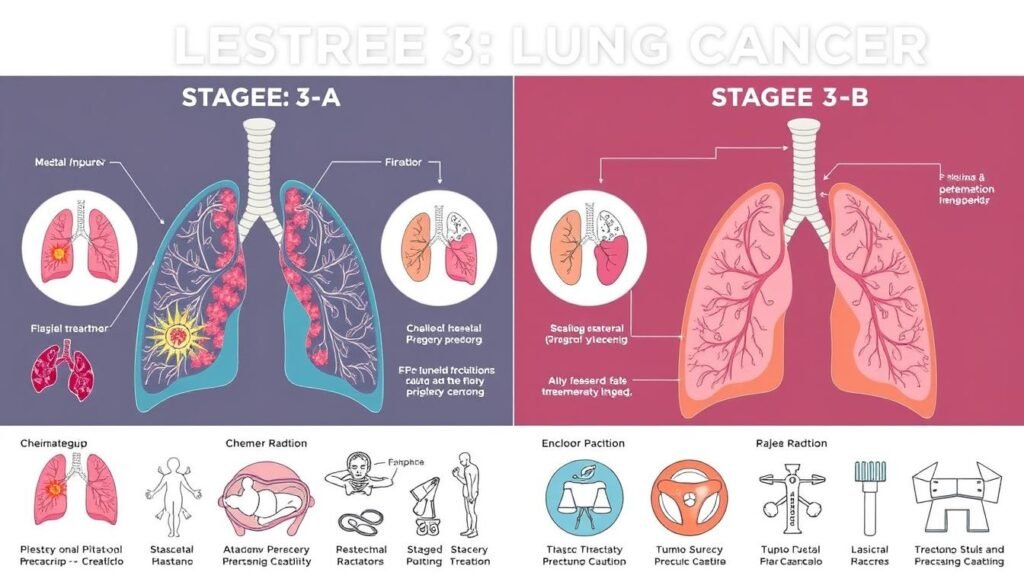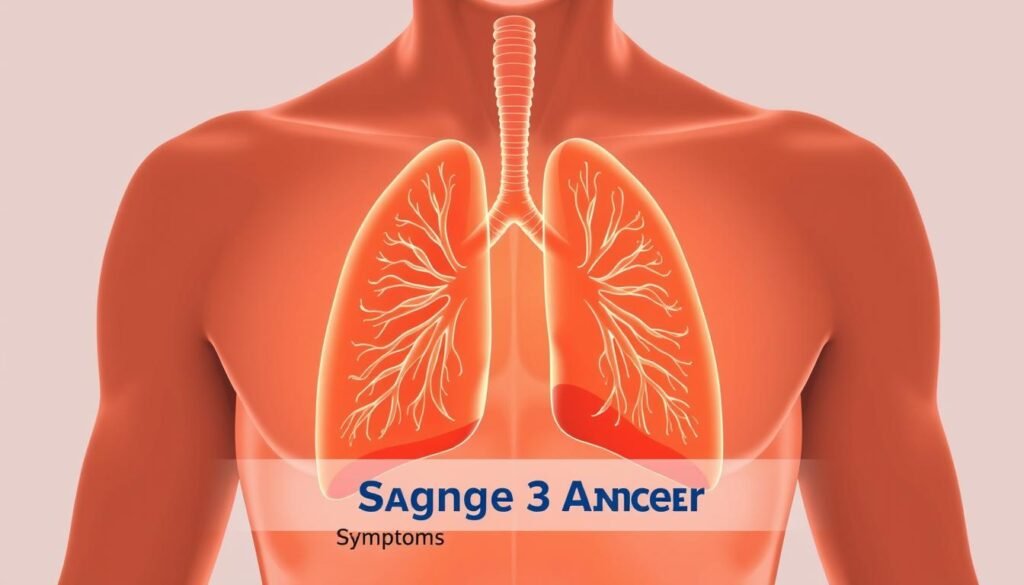Did you know that almost 90% of people with lung cancer have non-small-cell lung cancer (NSCLC)? This fact shows how common NSCLC is, especially as it gets more advanced. When talking about stage 3 lung cancer prognosis, knowing the details and treatment options is very important. This knowledge can help improve patient outcomes and life quality. At this stage, the cancer usually spreads to nearby lymph nodes or tissues, which means quick action is necessary. The size and location of the tumor are key in deciding on treatment for stage 3 lung cancer life expectancy.
Treatment for advanced lung cancer may involve surgery, chemotherapy, and radiation. There are also new treatments like targeted therapy and immunotherapy. Understanding the prognosis is vital. It allows patients to make wise health decisions. Even though lung cancer statistics can be scary, having knowledge is powerful. Acting early can greatly improve treatment success. For more on symptoms and how they impact daily life, check out this resource.
Key Takeaways
- Stage 3 lung cancer can be divided into three sub-stages: IIIA, IIIB, and IIIC.
- About one-third of lung cancer patients are diagnosed at stage 3.
- The average 5-year survival rate for stage IIIC lung cancer is only 13%.
- Advanced treatments are crucial for improving stage 3 lung cancer prognosis.
- Understanding symptoms early can enhance both treatment outcomes and emotional well-being.
Understanding Stage 3 Lung Cancer
Stage 3 lung cancer is a crucial juncture in its lung cancer stages. It’s marked as a locally advanced disease. Tumors can be very different in size and location. Usually, this stage affects one lung and nearby lymph nodes but hasn’t spread far.
The TNM staging system is vital for doctors. It helps them understand the disease’s severity and plan treatment. Knowing the outlook for stage 3 lung cancer is key. About one-third of lung cancer diagnoses are at this stage.
Stage 3 is divided into subcategories (3A, 3B, 3C). These show how much the tumor has spread and lymph node involvement. Each level affects treatment choices and how well a patient might do. Survival rates fall as the cancer gets worse.
For instance, non-small cell lung cancer survival rates differ greatly. If the cancer stays in the lung, the five-year survival rate is 64%. This drops to 37% if it spreads nearby and to 8% if it reaches distant areas. Understanding these rates helps patients and their families face tough situations.
About 30% of lung cancer cases are found at this late stage. Thus, detailed knowledge about stage 3 lung cancer prognosis is crucial. It helps patients make informed choices about their treatment. A personalized treatment plan, looking at health and tumor type, is best for optimal outcomes.
Types of Lung Cancer: Focus on Non-Small Cell Lung Cancer
Non-small cell lung cancer (NSCLC) makes up about 80-90% of all lung cancer cases. It grows slower than small cell lung cancer (SCLC). NSCLC includes types like adenocarcinoma, squamous cell carcinoma, and large cell carcinoma. Each one is different and needs its own treatment approach.
About 40% of NSCLC cases are adenocarcinomas, the most common form in the U.S. Squamous cell carcinoma accounts for around 30% of NSCLC cases. Large cell undifferentiated carcinoma makes up 10-15% of NSCLC. Knowing these types helps doctors treat lung cancer more effectively.
For stage 3 non-small cell lung cancer, different therapies are often combined. Surgery can remove the tumor if the cancer hasn’t spread far. Radiation therapy focuses on killing cancer cells and saving healthy ones. Chemo uses drugs to slow or kill cancer, usually given through the veins.
In advanced NSCLC, new treatments target specific cancer cell changes to stop them from growing. Immunotherapy boosts the immune system to fight cancer. These methods aim to extend life and improve its quality for people with this lung cancer stage.
Stage 3 Lung Cancer Prognosis
Stage 3 lung cancer varies in survival chances, especially within the non-small cell lung cancer (NSCLC) subtype. Knowing the survival rates and factors that affect prognosis helps guide treatment choices and patient expectations.
Survival Rates for Non-Small Cell Lung Cancer
The survival rates for stage 3 lung cancer depend on the subtype and the patient’s specific details. For example, stage 3a NSCLC has a five-year survival rate of around 36%. This rate drops to 26% for stage 3b and goes down further to 13% for stage 3c. Overall, stage 3 NSCLC has a 37% five-year survival rate, according to SEER data.
- Stage 3a NSCLC: 36% five-year survival rate
- Stage 3b NSCLC: 26% five-year survival rate
- Stage 3c NSCLC: 13% five-year survival rate
- Stage 3 small cell lung cancer (SCLC): 18% five-year survival rate
Surgeries like sleeve lobectomy in stage 3a can lead to survival rates up to 62.7%. Meanwhile, a pneumonectomy shows a survival rate of 43.1%. These numbers show how crucial surgery is for improving life expectancy in stage 3 lung cancer. Treatments like chemotherapy, targeted therapies, and immunotherapy also help in boosting survival rates.
Prognosis Factors Influencing Outcomes
It’s important to know the factors that influence lung cancer outcomes. Key factors are:
- Age
- Overall health of the patient
- Type and size of the tumor
- Smoking status
- Biological aspects of the cancer, like histology and genetic markers
These factors affect how a patient responds to treatment and their recovery chances. Age, for instance, can greatly change survival odds, with older adenocarcinoma patients having a five-year survival rate of 44.9%. A patient’s overall health also determines their ability to endure tough treatments.

Understanding the prognosis of stage 3 lung cancer gives patients and healthcare providers valuable insights. It helps them make treatment plans that specially fit the patient’s needs and supports making informed health decisions.
Subcategories of Stage 3 Lung Cancer
Stage 3 lung cancer breaks down into IIIA, IIIB, and IIIC. Knowing these helps doctors decide on treatment and predict outcomes. Each subtype shows how far the cancer has spread and the lymph nodes involved. This changes how doctors treat the cancer.
Understanding Stage IIIA, IIIB, and IIIC
Stage IIIA lung cancer means the tumor is still in one lung but has spread to nearby lymph nodes. These cases can often be treated with a mix of therapies. On the other hand, IIIB has more lymph nodes involved, even above the collarbone or on the other side of the chest. This requires a detailed treatment plan.
Stage IIIC is when the cancer has grown the most within stage 3. It may reach the chest wall or pleura, but not farther. Knowing the specific subtype, IIIA, IIIB, or IIIC, helps doctors create the best treatment plans.

Symptoms Associated with Stage 3 Lung Cancer
Understanding lung cancer symptoms is crucial for early treatment. Stage 3 lung cancer patients need to know these signs to manage their illness. These symptoms can greatly affect daily life.
Common Symptoms of Lung Cancer Patients
Stage 3 lung cancer symptoms include:
- Coughing that persists and may worsen over time
- Chest pain that could be sharp or dull
- Fatigue that interferes with daily activities
- Weight loss that occurs without any intentional dietary changes
- Difficulty breathing or shortness of breath
- Wheezing sounds while breathing
Symptoms depend on the lung cancer type and its progression. Patients might also feel bone pain or see swelling in lymph nodes, showing the cancer has spread.
When to Seek Medical Attention
Patients should see a doctor without delay if they notice symptoms. Waiting can make treatment less effective. Early action often means better results. Stage 3 lung cancer patients might improve with nutritional support, like dietary supplements.

Diagnosis and Staging Techniques
Proper diagnosis and staging are key for managing lung cancer effectively. It’s important to get a thorough assessment to know the disease’s extent and nature. The TNM staging system is a top method used. It looks at the tumor’s characteristics (T), checks lymph nodes (N), and sees if the cancer has spread (M). This helps doctors plan the best treatment for each patient.
Utilizing the TNM Staging System
The TNM staging system is key for understanding how far lung cancer has progressed. It classifies cancer based on tumor size, lymph nodes, and spread. This lets doctors predict outcomes and plan treatments better. It helps them talk about cancer stages clearly, making decision-making easier.
Common Diagnostic Tests
Several tests are important for diagnosing and staging lung cancer. These include:
- Chest X-rays: Initial screenings that reveal lung abnormalities.
- CT Scans: Detailed images helping to evaluate tumor size and lymph node involvement.
- PET Scans: Useful for identifying cancerous tissues and metastasis.
- MRIs: Particularly effective when assessing brain involvement.
- Biopsies: Essential for confirming the presence of cancerous cells.
Imaging and testing techniques are vital in managing lung cancer. They help doctors diagnose and stage the disease, guiding treatment. These techniques also give patients better understanding of their lung health. They help in conversations about their treatment plans.
| Diagnostic Test | Purpose |
|---|---|
| Chest X-ray | Initial assessment for lung abnormalities |
| CT Scan | Detailed imaging for tumor size and lymph node assessment |
| PET Scan | Identifies cancerous tissue and spread |
| MRI | Evaluates potential brain involvement |
| Biopsy | Confirms presence of cancerous cells |
Using these tests along with the TNM staging system establishes a solid approach to lung cancer care. This ensures patients get the care tailor-made for them.
Advanced Lung Cancer Treatment Options
Treating stage 3 lung cancer requires different methods. It’s important to look at the person’s health and the cancer’s details. The goal is to either remove the cancer or help manage symptoms. This can help improve survival chances.
Surgical Interventions: Lobectomy and Pneumonectomy
Surgery is important for treating stage 3 lung cancer. A lobectomy is often the first choice. This means removing part of the lung. If the cancer is more serious, removing the whole lung, or a pneumonectomy, might be needed. Research shows surgery can really help patients live longer, especially with other treatments.
Chemotherapy, Radiation, and Chemoradiation
Chemotherapy works well with surgery or radiation. It helps shrink tumors and kill cancer cells. Radiation therapy can also be used alone for cancers that can’t be removed. Using these methods together, called chemoradiation, can improve results. Research found that adding immunotherapy before surgery can raise the two-year survival rate to 85%.
Emerging Treatments: Targeted Therapy and Immunotherapy
New treatments for advanced lung cancer are showing promise. Targeted therapy focuses on mutations in cancer cells. Immunotherapy boosts the immune system’s cancer-fighting abilities. Studies show combining Durvalumab (Imfinzi®) with chemotherapy led to patients living about 47.5 months on average. This is a big step forward in treatment.
| Treatment Type | Average Survival Rate | Comments |
|---|---|---|
| Surgery (Lobectomy) | Varies by patient | Removes cancerous lung tissue, improving prognosis. |
| Chemotherapy | 29 months average | Often combined with other treatments for better outcomes. |
| Chemo + Immunotherapy | 47.5 months | Combination treatment leads to significant survival increases. |
| Chemoradiation | 63.6% two-year survival | Effective for local disease control and symptom relief. |
| Targeted Therapy | Improved outcomes with specific mutations | Minimizes damage to healthy cells. |
| Immunotherapy | Enhanced immune response | Promising results in advanced lung cancer settings. |
For more details on treatment options, click here.
Palliative Care for Lung Cancer Patients
Palliative care is key in treating lung cancer, especially in advanced stages. It focuses on easing symptoms and improving life quality. Patients get help with pain, breathing issues, and tiredness. Treatments like medicine, breathing help, and even massage are used, based on what each person needs.
The Importance of Symptom Management
Controlling symptoms is critical for the well-being of lung cancer patients. They often face many symptoms, some quite severe. Severe breathing difficulty is common, affecting many in late stages. Palliative care aims to lessen these challenges from diagnosis to advanced stages. It helps patients stay comfortable and maintain dignity.
Emotional Support and Counseling Services
Emotional support is vital in palliative care. High depression rates are seen in lung cancer patients. Counseling and support groups provide crucial help. They help patients and families handle cancer’s emotional impact. By addressing mental health, patients find meaning and improve their life quality. This care covers patients’ emotional, physical, and psychological needs, offering needed support. For more details, visit the American Lung Association.